Wind, kayaks and folklore: The enduring charm of the Orkney islands

Bit ’o wend today,” says the Orcadian; except it’s a habitual greeting - it might be blowing like hell. In some ways, it’s commendable that complaining about the weather is virtually unknown in Orkney, given how regularly the sea is raucous enough to broach the land and close roads.
It’s impossible to ignore the wind, though, because it constitutes both weather and conversation.
Orcadian endurance hides an astute mind for the breeze. They’re wind aficionados, keenly marking the incremental differences between the light skiff of a kuil and a slightly stiffer tirl, and on upward through a gurl, a gushle, a hushle, a skolder, a skuther, a gouster, right up to the strong, muscular blast of a skreevar. Even the wind that rushes down the chimney pipe to scatter the ashes has a name: flan. When the wind falls, as it occasionally does, there are some 17 words for drizzle to draw on instead.
On an archipelago so wind-whipped, it’s not surprising that the farmers offer the best travelling advice. Their masterful knowledge of all things elemental, the kind that few others can come close to, is the advantage that comes from rarely leaving home.
“I’ve lived here my whole life,” a farmer on South Ronaldsay told me. He meant just that – he had always sat in that chair, in that house, looking out of that window, with its view of his sloping pasture and the sea beyond. Hearing my accent, he mentioned he might like to visit Canada one day, provided he could be back in time for tea. His advice: “When you hear the sea roaring on a nice day, there’s bad weather coming.”
The sea was roaring. The wind was tirlish. I took my kayak and hurried down to the water.
The water of Scapa Flow was polished and calm, the peaks of distant Hoy clearly defined against the morning sky. The stillness of Scapa was deceiving. The Churchill Barriers, which were built during the Second World War to protect the natural harbour, and now connect South Ronaldsay to the Orcadian mainland by road, also insulate the water from the raging North Sea. The water can be as smooth as glass within the confines of Scapa while beyond the barrier, the North Sea surges with whitecaps. The opposite can be just as true.
In Orkney, life lies near the water, but not fully in it. I met lifelong Orcadians who had never once set foot in the sea, despite living less than a mile from the shore. The essence of the islands hovers somewhere between field and fish; Orcadians remain, as George Mackay Brown had it, fishermen with ploughs. Adrift in my kayak on that liminal edge of sea and land, I was only a stone's throw from the island’s living history: a fisherman throwing creel pots, a seaside pasture dotted with sheep, the rusted mast of a sunken shipwreck, a scar of neolithic remains.

“There’s a crypt there in that moond, just waiting to be dug up,” an old woman told me in Voy parish, pointing to a grassy knoll beside her house. “Imagine the treasure!” It was hardly an exaggeration - Skara Brae, Maeshowe, and countless other Neolithic ruins were discovered just that way, by some farmer scratching away at a strange hillock. Excavation didn’t interest this old woman much. Instead, she spent her time collecting fairy stories from across Orkney, of the friendly seal-skinned selkies, and the murderous finfolk, who troll the shoreline looking for victims.
Predictably, demons also have a say in the weather. It’s the Nuckelavee that brings in the sea storms, and the Sea Mither that calms them. The various wrecks along the Churchill Barriers are impressive, but intentional accidents; before the barriers sealed off Scapa Flow, ships were scuppered to defend it against U-boats. But the waters at large are dangerous, and there are plenty of unplanned wrecks lining the coast to prove it, their cinnabar debris cluttering the shorelines.
Along the eastern coastline of South Ronaldsay, the coastal cliffs are genuinely frightening, the cavernous gloups echoic with waves that hit the sheer rock and rise against the walls, stained white by centuries of squatting fulmar gulls. These brave, soft-eyed birds are curious, and dip down to scrutinise my paddling. Skimming the waves, they timed the sea roll perfectly, the tips of their wings only inches from the water.
In a kayak, feet jammed against the footrest, insulated from the cold and wet by a drum-tight skirt, I was warm and safe
It’s the outsider who sees Orkney as small. Bobbing in the waves, turned insignificant by towering cliffs, it was easy to see why the islanders themselves see their home as a world unto itself.
History is close to the bone here, and old distinctions have carried forward to today. Deerness is the “back of beyond;” those from Rendall are sheep thieves. On the isle of Stronsay, they eat limpets; in Firth, it’s oysters. Distant North Ronaldsay sees more visits from foreigners than Orcadians. Those hailing from Kirkwall (“starlings”) feel so different from the Stromness crowd (“bloody puddings”), that couples are hesitant to admit to their parents when their lover is from another isle.
In a kayak, feet jammed against the footrest, insulated from the cold and wet by a drum-tight skirt, I was warm and safe. Perfected on artic ice floes and unchanged for millennia, it is the ultimate water vessel, one anyone can master. Once settled inside, a paddler isn’t so much on the water as in it. Like a good tool, a kayak is an extension of the body, neither as clumsy as a canoe nor as limiting as a paddleboard. In Orkney, it is the perfect way to visit the scattershot of islands, some of which are only large enough to fatten one sheep, feed two, or starve three. The entire archipelago can be reached this way, gliding from one island to the next.

I paddled along, keeping an eye on a cluster of gannets, a grouping delightfully referred to as a “newspaper syndicate.” They were feeding, each bird flying high into the air, where they folded into a tight arrow, and dropped headlong into the water like a clean, white torpedo. Watching them, I fell into a trance, and only faintly registered the cloud bank that obscured the distant cliffs.

The wind had picked up to a gushle, and was threatening to turn into a hushle. Paddling over a world of swirling undertow, I made for the shore. The sea, whipped so many ways by the sneaping wind, pushed me toward the cliffs. I surfed the kayak in, beaching it on an elbow of sand. A solitary young woman shuffled along the sea wrack, her back bent in a search for groatie buckies, cowrie shells that bring luck to the finder. That day, I was the lucky one, arriving on shore just as the wind had blown in a thick coat of fog. Seeing me hauling my kayak from the water, the girl smiles and hails me, her words carried off before they reach me. I waved back, confident in her message.
Read More

 Yahoo Finance
Yahoo Finance 